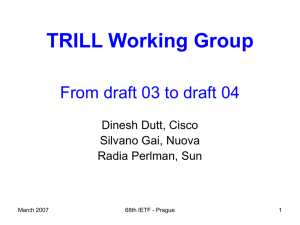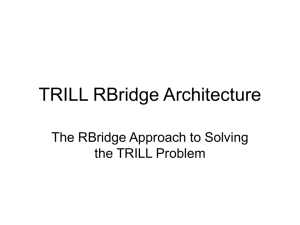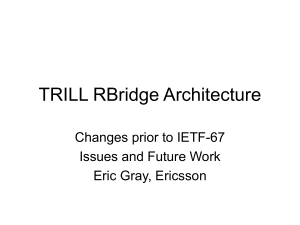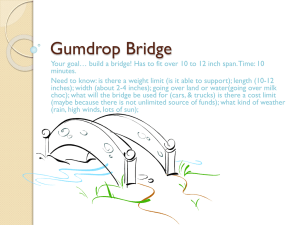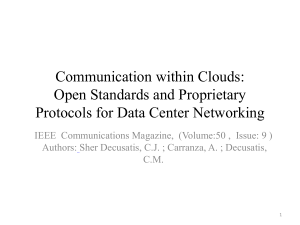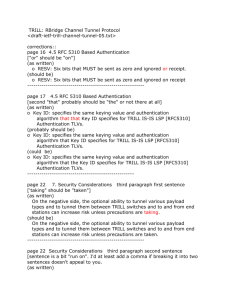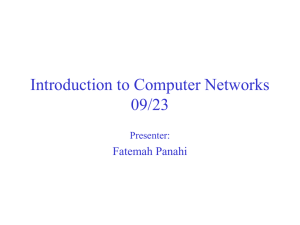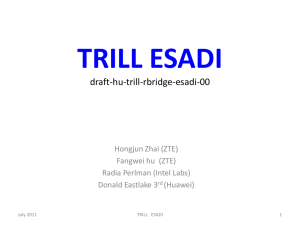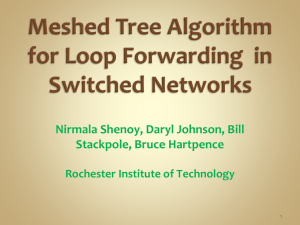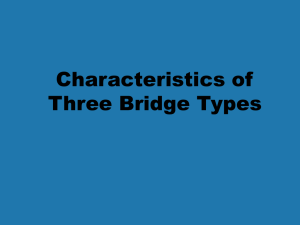Document
advertisement
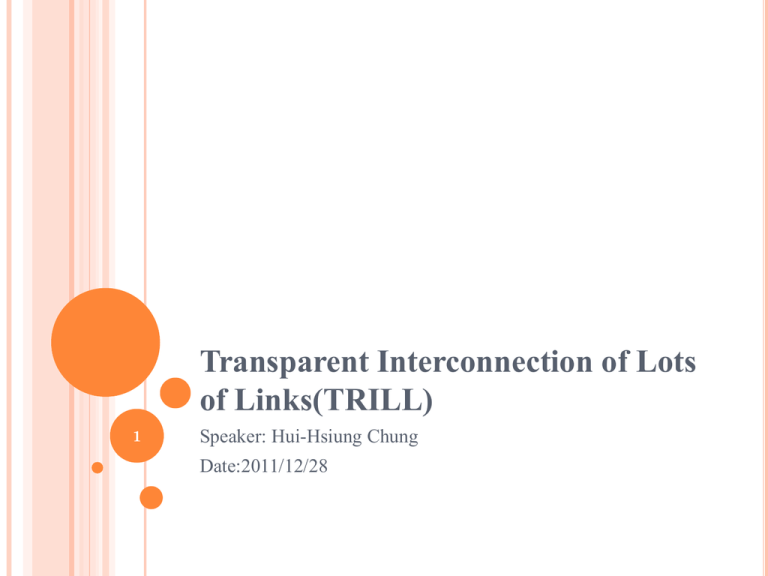
Transparent Interconnection of Lots of Links(TRILL) 1 Speaker: Hui-Hsiung Chung Date:2011/12/28 Introduction Spanning Tree Protocol(STP) A protocol that ensures a loop-free topology for any bridged Ethernet local area network. Bridge TRILL A protocol to perform Layer 2 bridging using Intermediate System to Intermediate System(IS-IS) link state routing. Routing Bridge(RBridge) 2 STP I think that I shall never see A graph more lovely than a tree. A tree whose crucial property Is loop-free connectivity. A tree which must be sure to span So packets can reach every LAN. First the Root must be selected By ID it is elected. Least cost paths from Root are traced In the tree these paths are placed. A mesh is made by folks like me. Then bridges find a spanning tree. Radia Perlman 3 STP Cont. A 2,1,6 2,2,11 11 X 3 2,3,3 6 7 2,1,7 9 2,0,2 2 5 10 2,2,4 2,0,2 4 14 2,2,4 2,1,5 2,1,14 P.S. lowest root bridge id, lowest path cost, lowest sender bridge id 4 Introduction Spanning Tree Protocol(STP) A protocol that ensures a loop-free topology for any bridged Ethernet local area network. Bridge TRILL A protocol to perform Layer 2 bridging using Intermediate System to Intermediate System(IS-IS) link state routing. Routing Bridge(RBridge) 5 IS-IS A link state routing protocol Developed by DECnet Phase V Routing Protocol OSPF IS-IS Algorithm Dijkstra Dijkstra Classless(VLSM) Support Support Network Original for IP Original for CLNS Address IP NSAP Topology Point-to-point Point-to-multicast Broadcast Nonbroadcast Point-to-point Broadcast 6 RBridge Compatible with existing bridges and routers Like routers, terminate bridges’ spanning tree Like bridges, glue LANs together a IP subnet Like routers, optimal path, fast convergence Like bridges, plug-and-play Link state protocol among RBridges Like bridges, learn location of end-nodes from receiving data traffic 7 TRILL TRILL Header V (Version): 2-bit R (Reserved): 2 –bit M (Multi-destination): 1 bit Op-Lng (Options Length): 5-bit Hop Count: 6-bit Egress RBridge Nickname: 16-bit identifier Ingress RBridge Nickname: 16-bit identifier TRILL Ethertype Egress RBridge Nickname V R M OPLng Hop Ingress RBridges Nickname 8 RBridging BR5 BR6 BR7 BR4 LAN BR3 BR2 BR1 9 Comparison Bridges with STP :end-node B1 B2 B3 10 Comparison Cont. RBridges with TRILL B1 B2 B3 11 Conclusion I hope that we shall one day see A graph more lovely than a tree. A graph to boost efficiency While still configuration-free. A network where RBridges can Route packets to their target LAN. The paths they find, to our elation, Are least cost paths to destination! With packet hop counts we now see, The network need not be loop-free! RBridges work transparently, Without a common spanning tree. Ray Perlner 12 Reference RFC 5556 RFC 6325 Tutorial on Bridges, Routers, Switches, Oh My! Bridges and the TRILL protocol 13 Network Devices Device Repeater Hub Bridge Switch OSI Layer Layer 1 Layer 1 Layer 2 Layer 2 Number of port 2 >2 2 >2 Back 14
